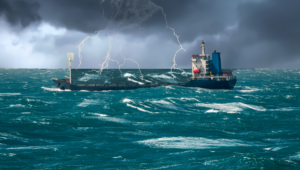The skyrocketing price of oil is a great example of how a horizontal shock affects the system. Everything from gasoline to the price of food is affected. Owners of shipping lines are also concerned that rising oil prices will adversely affect their bottom lines. To help reduce fuel costs, they may turn back to nature and to wind power [“Slower boats to China as ship owners save fuel,” by Erik Kirschbaum, Reuters, 20 January 2008]. The device that is being touted for harnessing the wind is not so much a sail as a kite.
“Higher fuel costs and mounting pressure to curb emissions are leading modern merchant fleets to rediscover the ancient power of the sail. The world’s first commercial ship powered partly by a giant kite sets off on a maiden voyage from Bremen to Venezuela on [22 January], in an experiment which inventor Stephan Wrage hopes can wipe 20 percent, or $1,600, from the ship’s daily fuel bill. ‘We aim to prove it pays to protect the environment,’ Wrage told Reuters. ‘Showing that ecology and economics are not contradictions motivates us all.’ The 10,000-tonne ‘MS Beluga SkySails’ — which will use a computer-guided kite to harness powerful ocean winds far above the surface and support the engine — combines modern technology with know-how that has been in use for millennia.”
Kirschbaum notes, however, that the high tech kite has competition from another, simpler solution — slowing down — the same tactic used by motorists concerned with getting better gas mileage.
“The world’s 50,000 merchant ships, which carry 90 percent of traded goods from oil, gas, coal, and grains to electronic goods, emit 800 million tonnes of carbon dioxide each year. That’s about 5 percent of the world’s total. Also, their fuel costs rose by as much as 70 percent last year. That dramatic increase has ship owners clambering onto a bandwagon to reduce speed as a way to save fuel and cut the greenhouse gases blamed for global warming, said Hermann Klein, an executive at Germanischer Lloyd classification society. ‘The number of shipping lines reducing speed to cut fuel costs has been growing steadily,’ Klein, whose organization runs safety surveys on more than 6,000 ships worldwide, told Reuters. ‘Slowing down by 10 percent can lead to a 25 percent reduction in fuel use. Just last week a big Japanese container liner gave notice of its intention to slow down,’ he added. Shipping was excluded from the U.N.’s Kyoto Protocol to slow climate change, and many nations want the industry to be made accountable for its impact on the climate in the successor to Kyoto, which runs to 2012.”
If cargo vessels are added to any future protocol, the kite and other ideas for improving fuel efficiency may become popular with shipping lines. For now, however, slowing down seems to be working.
“In Hamburg, the Hapag-Lloyd shipping company is not waiting for 2012. It reacted to rising fuel prices by cutting the throttle on its 140 container ships traveling the world’s oceans, ordering its captains to slow down. The company in the second half of last year reduced the standard speed of its ships to 20 knots from 23-1/2 knots, and said it saved a ‘substantial amount’ of fuel. The calculation used in shipping is complex: longer voyages mean extra operating costs, charter costs, interest costs and other monetary losses. But Hapag-Lloyd said slowing down still paid off handsomely. … Slowing down has not involved a decrease in capacity for the company. For container ships carrying mainly consumer goods from Hamburg to ports in the Far East, the round-trip at 20 knots now takes 63 days instead of 56, but to make up for this it added a vessel to the route to bring the total to nine.”
The company is saving money even with the addition of a ship. It’s not clear from the article, however, if emission reductions were negated by the adding the extra vessel. Other lines are reducing speeds with money savings and the environment in mind.
“The world’s largest container shipping operator, Danish group A.P. Moller-Maersk, is also going slower to cut emissions — although Eivind Kolding, chief executive of the group’s container arm, told the January event this would mean a delay to clients of 1-1/2 days. He added he believed that was a price customers were willing to pay for the sake of the environment.”
If that attitude catches on with other shipping companies, kites may catch on as way to save both money and the environment (like hybrid cars are making it big in the automotive industry). The company making the kites certainly hopes that becomes the case.
“If fuel prices keep rising, innovations like the kite powered ‘Beluga SkySails’ could also pay off. German-based Beluga Shipping has already ordered two more vessels and Wrage’s company has a total of five orders in hand. If the maiden voyage is a success, inventor and chief executive Wrage hopes to double the size of its kites to 320 square meters, and expand them again to 600 square meters in 2009. The company hopes to fit 1,500 ships by 2015.”
Although designs for solid sails (more like vertical wings) have been around for a few years, the advantage of kites over those designs is that they don’t take up valuable deck space needed for cargo. The world’s oceans will continue to be it most important highways, with 90 percent of the world’s bulk cargoes continue to move via the sea lanes. Making them efficient and environmentally friendly will remain important whatever the price of crude oil. If transit speeds slow, other efficiencies need to be found. Enterra Solutions® is beginning work on an idea for creating a Trusted Supply Chain aimed at making the flow of goods more efficient. Keeping goods flowing over the oceans is an important part of the success of globalization.




